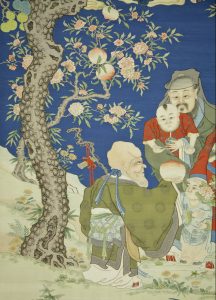
Explore Ancient Chinese Art & Culture
Highlighting works from VMFA’s East Asian art collection, this resource explores Chinese art and culture.
Chinese Calligraphy
Calligraphy, or the art of writing, was historically considered the highest visual art form in China. To study and develop their skills, students of calligraphy would copy the works of well-known practitioners, using brushes, ink, inkstone, water, and paper to write and paint.
Chinese calligraphy is practiced with what are called the Four Treasures of the Study: brush, paper, ink, and inkstone. These functional items took on great significance as symbols of study and scholarship. These tools used to create artwork are often so beautifully crafted that they, too, are considered works of art.
Watch as skilled calligrapher Yi Hao, a volunteer teacher from the Confucius Institute at The College of William & Mary writes the characters found in this interactive. Modern calligraphers work with the same basic tools as those writing thousands of years ago.
Try writing the Chinese characters in the slides below and learn more about symbols of good fortune that can be found in VMFA’s collection of Chinese art.
When students learn to write Chinese characters, they also learn that the strokes are to be written in a certain order. The rules for writing Chinese characters are based on creating a smooth motion with your hand, which will make your writing more efficient and beautiful. As a general rule, strokes are written from left to right and top to bottom. Horizontal strokes are usually written before vertical ones.
Chinese Seals
Traditionally made from precious stones, seals contain the names of artists, collectors, and their studios or even their favorite poetic phrase. Carved seals are used to stamp red paste onto Chinese paintings or calligraphy as a symbol of ownership or authorship. Scroll through to learn more!
In this video, a young man practices carving a stone seal to get a sense of how it feels to work with the material and a carving tool. Traditional Chinese seal carving, however, is an art form that takes many years of practice. Considered one of the essential skills for ancient Chinese scholars, seal carving requires a mastery of both the art of calligraphy and carving.
Chinese Painting
There are a variety of formats used in traditional Chinese painting and calligraphy. Typically, these works are created by artists on sheets of paper or silk that are laid on a flat surface and then mounted onto similar material with water soluble glue. Most of these works of art are meant to be shown only occasionally and then put away in storage. Explore three formats of Chinese painting.
About this Hanging Scroll: In Praise of the Three Stars
This remarkable silk tapestry in VMFA’s collection depicts legendary Chinese deities known as the Three Stars.
The entire tapestry is woven in the cut-silk (kesi) technique. Gold and silver embroidery form the figures’ costumes, and their facial features are painted in fine lines.
The integration of cut-silk weaving, embroidery, and painting make this scroll among the most spectacular tapestries produced in the Suzhou imperial workshops during the 18th century.
This video shows a museum conservator examining VMFA’s painting made in the style of Xi Gang, The Pleasures of Fishing in a Mountain Stream. Watch to see how a scroll is slowly unrolled from right to left, in the same direction as Chinese text.
CHINESE BRONZE BELLS
For thousands of years music has been an important part of Chinese culture, including religious and public ceremonies, scholarly pursuits, and entertainment. One or a group of bronze bells were designed to be suspended on a wooden frame. Striking each bell with a wooden mallet, ancient musicians played the bells from a sitting or kneeling position.
Watch this video of the bronze bells being played at the Hubei Provincial Museum in Wuhan, China.


















